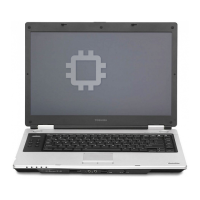
Do you have a question about the Toshiba Satellite M45 and is the answer not in the manual?
| Graphics | Intel Graphics Media Accelerator 900 |
|---|---|
| Wireless | Intel PRO/Wireless 2200BG (802.11b/g) |
| Battery | 6-cell Lithium-Ion |
| Networking | 10/100 Ethernet |
| Chipset | Intel 915GM |
| RAM | 2GB DDR2 SDRAM |
| Display | 15.4" WXGA (1280 x 800) |
| Optical Drive | DVD-RW |
| Operating System | Windows XP Home |
| Dimensions | 14.2" x 10.5" |
| Ports | 3 x USB 2.0, 1 x VGA, 1 x S-Video, 1 x RJ-45, 1 x Headphone, 1 x Microphone |
Guidelines for periodic backup of data to prevent loss due to hardware failures.
Equipment tested and found to comply with Class B digital device limits.
Information pertaining to FCC Part 15 and Part 68 rules for internal modems.
Procedures for handling telephone network issues and contacting support for repair.
Notice regarding Industry Canada certification requirements for equipment.
Information on regulatory compliance and safety standards for wireless devices.
Guidelines for safe usage of wireless devices to minimize RF exposure.
Regulations for radio frequency machinery and telecommunication laws in Taiwan.
Lists countries/regions where the Atheros AR5BMB-43/44 Mini PCI adapter is approved for use.
Introduces the computer's features and how to use the guide effectively.
Guidelines for setting up a comfortable and appropriate computing environment.
Tips for placing the computer and protecting the work area from environmental factors.
Advice on avoiding strain and stress injuries while using the computer.
Proper placement of the computer and external devices to avoid stress-related injuries.
Guidelines for adjusting your chair and maintaining good posture for computing comfort.
Tips for proper lighting to improve readability and reduce eyestrain.
Recommendations for maintaining a relaxed, neutral position for typing.
Strategies for varying activities and taking breaks to reduce stress and improve efficiency.
Steps to follow during the initial software setup using the Setup Wizard.
Instructions for safely opening the computer's display panel.
Information about system icons and potential configurations.
Steps to ensure external devices are connected and drives are empty before powering on.
Using the TouchPad's active regions for vertical and horizontal scrolling.
Explanation of primary (left) and secondary (right) button functions.
Instructions to change the TouchPad's enable/disable setting via Control Panel.
Steps to attach an external monitor or projector for a larger screen.
Using hot keys (Fn + F5) to select display output: internal, external, or simultaneous.
Adjusting video settings for optimal picture quality on external displays.
Step-by-step guide to installing a printer using the Windows Add Printer Wizard.
Essential tips for efficient computer usage, including saving work and backups.
Explanation of typing with character keys, noting differences from a typewriter.
How to use Fn key combinations to simulate additional Ctrl, Fn, and Alt keys.
Steps to launch programs via the Windows Start menu and All Programs list.
How to start programs by locating their executable files in Windows Explorer.
Instructions on how to save documents and specify file names and locations.
Guidelines for naming files, including length and character restrictions.
Identification of key components of the DVD-ROM or multi-function drive.
Identification of key components of the DVD-ROM or multi-function drive.
Ability to replace PC Cards while the computer is on.
Important precautions to avoid data loss when removing PC Cards during hot swapping.
Instructions for safely cleaning the computer's display panel and exterior.
Explanation of the computer's low-power standby mode and energy efficiency features.
Information on battery life variation, replacement, and maintenance for maximum capacity.
How to monitor the battery's remaining charge based on current power usage.
Important safety measures to follow when handling and using battery packs.
Tips for extending battery pack lifespan, including monthly discharge cycles.
Introduction to the Windows XP desktop as the primary interface for computer tasks.
Overview of standard desktop features: icons, Start button, taskbar, and system tray.
Explanation of what icons represent and how to create or use them on the desktop.
Functions of the Start button for launching programs, accessing help, and system settings.
How to find and potentially change the COM port name for modem connection.
How to connect the computer's built-in modem to a standard voice-grade telephone line.
Methods for connecting to office networks via Ethernet or home networks via dial-up.
Methods for connecting to office networks via Ethernet or home networks via dial-up.
Guidance on setting up office connections with network administrators or dial-up connections.
Steps to disable or enable the Ethernet LAN port for network connectivity.
Definition of the Internet as a global network of interconnected computers.
Explanation of the World Wide Web as a subset of the Internet using HTTP protocol.
Information about ISPs and methods for connecting to the Internet.
Instructions for playing audio CDs using Windows Media Player.
Instructions for inserting a PC Card into the computer's slot.
Steps for inserting a PCI Express Card into its designated slot.
Instructions for inserting various types of memory media into the adapter slot.
How to connect the computer's built-in modem to a standard voice-grade telephone line.
Program for creating desktop shortcuts and quick access to programs and files.
Provides quick access to computer functions and customization of settings.
Tool to control power usage, using preset modes or custom profiles.
Utility to enable confirmation messages for hotkey combinations like Standby and Hibernation.
Configuration management tool for accessing BIOS, hardware settings, and passwords.
Instructions for setting instant, power-on, or user passwords for system security.
How to set a supervisor password to prevent unauthorized hardware configuration changes.
Application to zoom in or out of specific applications or desktop icons.
Program that adds features to the TouchPad for launching applications or documents.


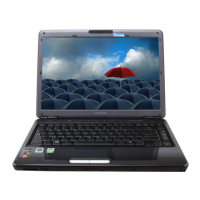


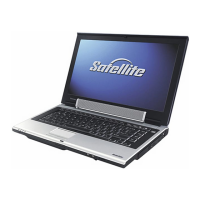

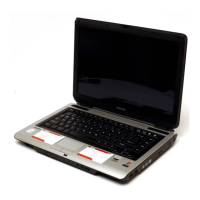

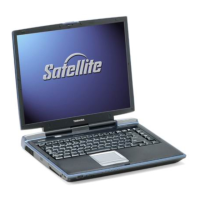

